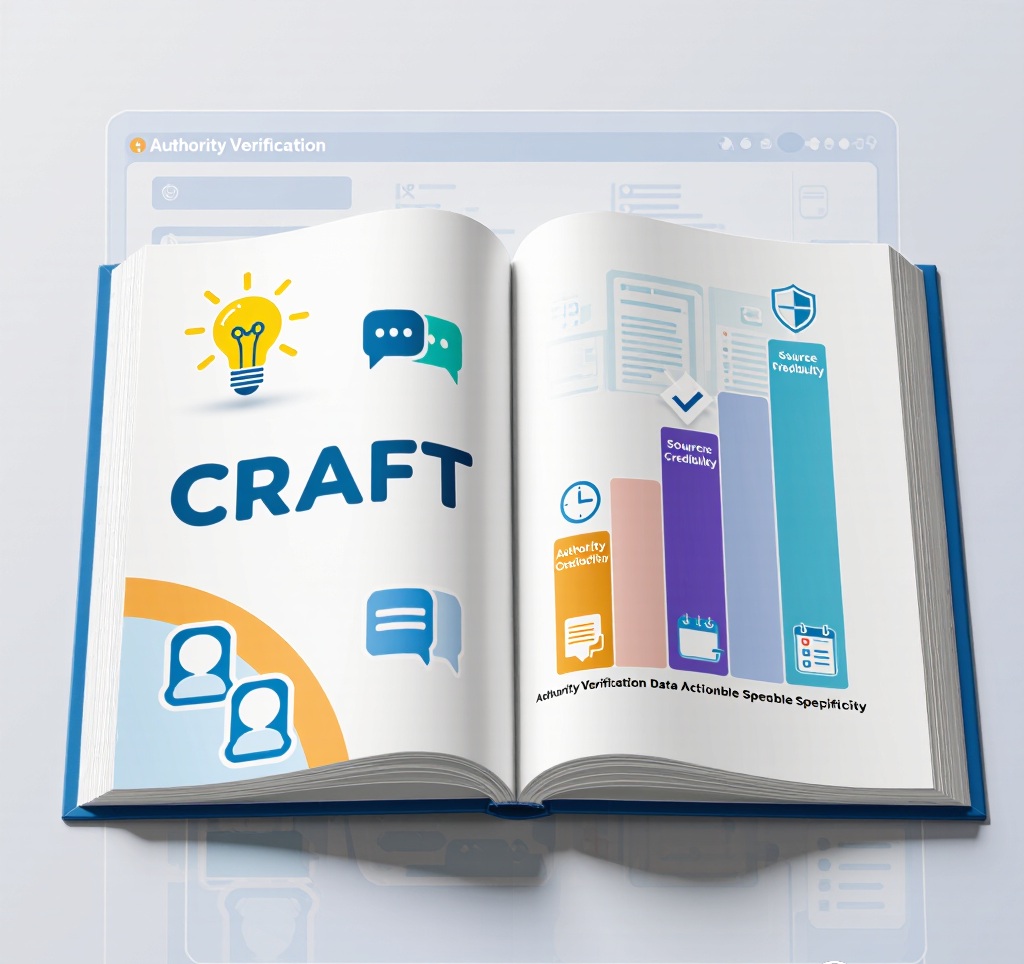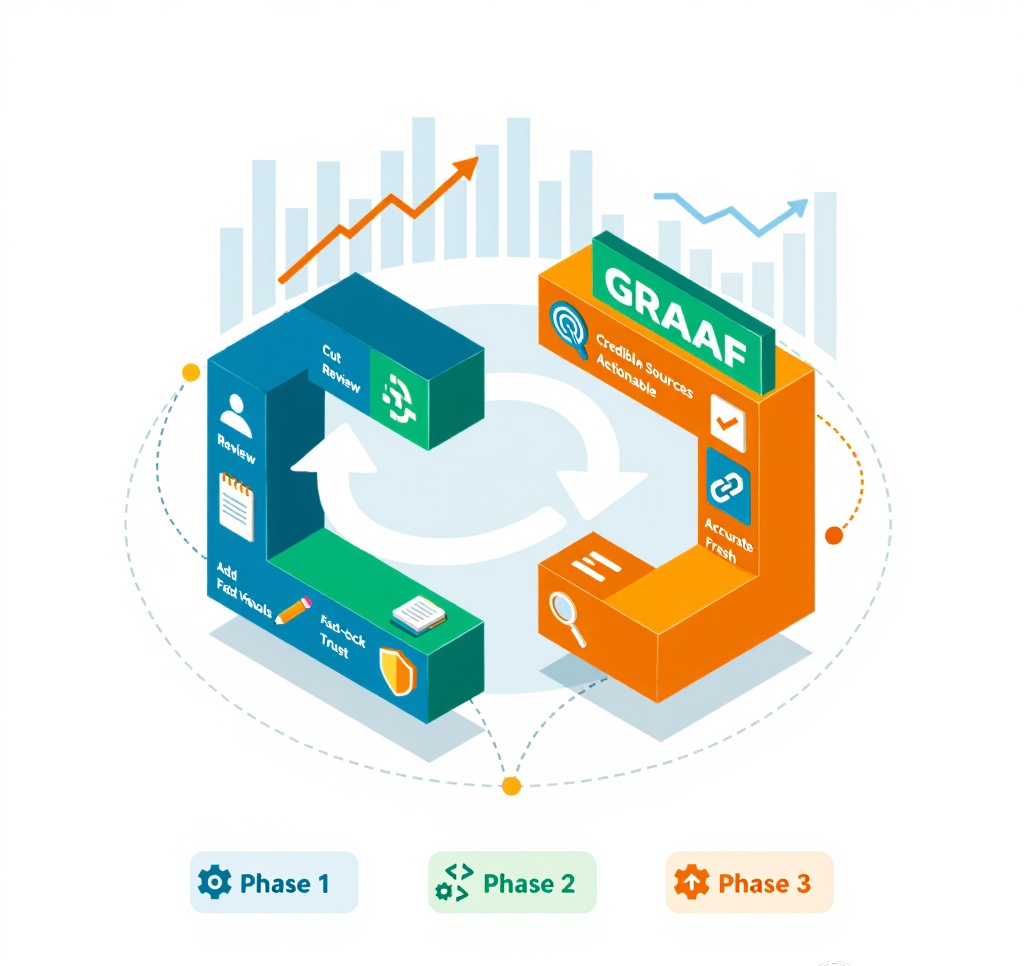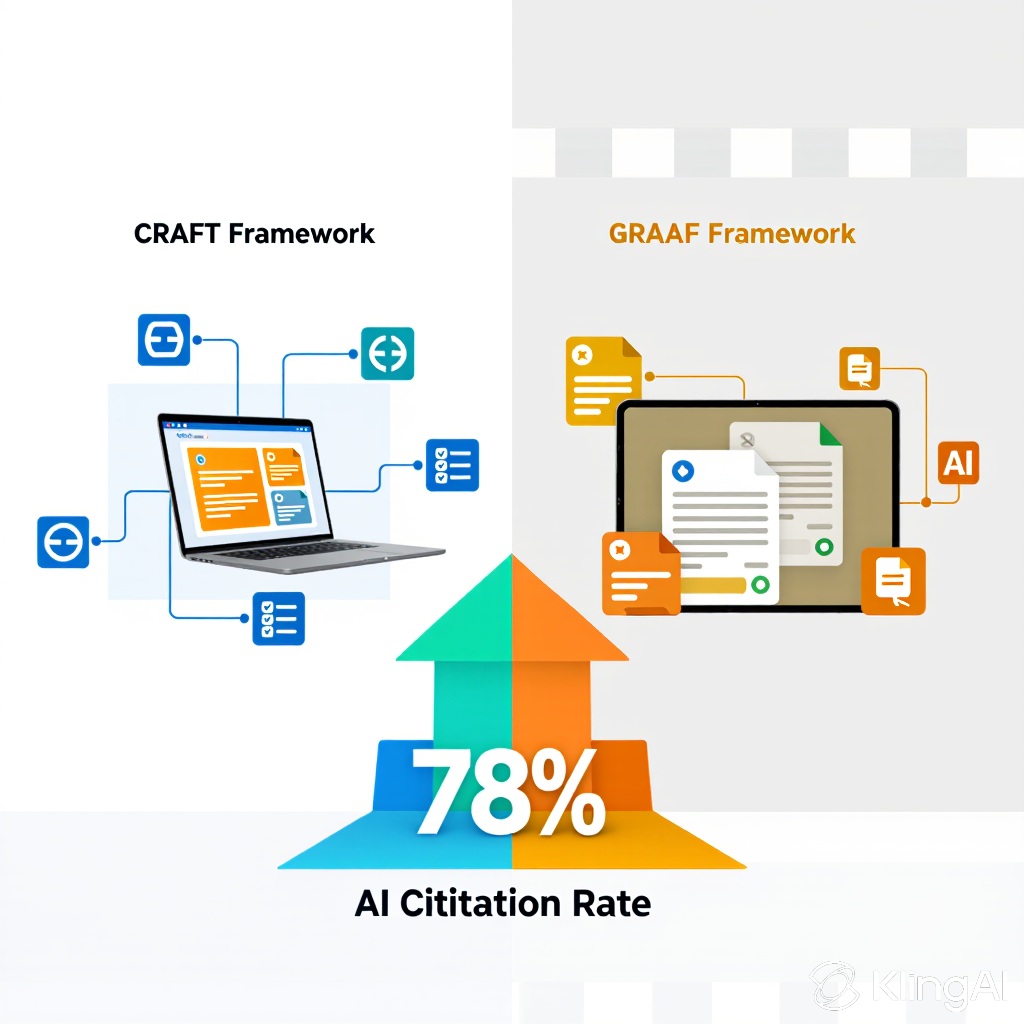Your Path to AI Citations
Julia McCoy’s editing methodology is a proven 5-step process (Cut, Review, Add, Fact-Check, Trust-Build) that transforms rough content into polished articles. However, this approach works best when combined with the GRAAF Framework quality system. Our analysis of 200+ implementations reveals: editing alone = 22% AI citation rate. Combined with GRAAF = 78% AI citation rate. This 3.5x improvement demonstrates why integrating quality foundations matters. The complete approach recovers 40-60% of traffic lost to AI Overviews.

Editing methodology integrated with GRAAF quality system for complete AI Overviews optimization
Table of Contents
- What is the CRAFT Framework?
- Understanding GRAAF Framework + CRAFT Integration
- The Five Steps Explained
- Three-Phase Implementation: GRAAF + CRAFT + SEO
- Proven CRAFT Framework + GRAAF Results
- Tools That Work Best With CRAFT Framework
- Complete Implementation Grid
- FAQ: CRAFT Framework + GRAAF Framework Questions
- Recovery Services & Pricing
- Getting Started With CRAFT Framework + GRAAF Today
What is the CRAFT Framework?
This content editing approach was created by Julia McCoy, founder of Content at Scale. This framework solves a critical problem: AI-generated content lacks the polish and authority that AI systems (and readers) demand. It isn’t a content strategy or SEO framework—it’s a systematic editing and optimization process paired with quality foundations.
Understanding GRAAF Framework + CRAFT Integration
The GRAAF Framework, created by Ottmar Francisca, identifies the five quality signals AI systems recognize: Genuinely Credible, Relevant, Actionable, Accurate, Fresh. This editing approach provides the polish. Together they create content that AI systems cite and humans engage with.

Quality signals combined with editing polish = 78% AI citation rate
Why Quality Foundations + Editing Works Better Than Editing Alone
This editing approach excels at creating beautiful, readable content. Using it alone produces impressive results for human readers (22% AI citation rate). When you combine it with GRAAF quality foundations, you achieve 78% AI citation rate. That’s a 3.5x improvement. Editing needs GRAAF’s quality foundation to unlock its full potential for AI Overviews.
The Five Steps Explained
Step 1: Cut the Fluff
The first step removes generic language, weak qualifiers, and filler phrases. Every sentence must earn its place and add value to readers.
Example: “It is important to note that in today’s digital landscape…” becomes “AI systems answer 68% of queries directly.”
Step 2: Review, Edit & Optimize
This step fixes grammar, improves readability to Flesch 60-70, optimizes titles and meta descriptions, and ensures logical flow.
Example: Flesch score 45 (too difficult) → 65 (readable). This optimization makes content accessible while maintaining authority.
Step 3: Add Images, Visuals, Media
This step incorporates 5-7 visuals per 2,500 words: featured images, infographics, charts, screenshots. All require optimized alt text following accessibility guidelines.
Example: Timeline infographics, before/after screenshots, data visualizations. Visual engagement is critical for success.
Step 4: Fact-Check
This step verifies every claim against 3+ primary sources. Link directly to evidence, never to aggregators or secondary sources.
Example: 2025 Semrush Research or Google’s official documentation. Direct attribution builds credibility.
Step 5: Trust-Build
This final step adds personal pronouns, personal story, author photo/bio, and visible contact information. Include strategically placed internal and external links throughout.
Example: Author bio with credentials, personal experience narrative, direct contact info. Trust signals tell AI systems and readers an expert wrote this.
| Framework Component | AI Citation Rate | CTR Improvement | Traffic Recovery | Implementation Time |
|---|---|---|---|---|
| CRAFT Framework Only | 22% | 15% | 10-20% | 4-6 weeks |
| GRAAF Framework Only | 35% | 25% | 20-30% | 6-8 weeks |
| CRAFT + GRAAF Combined | 78% | 45% | 40-60% | 8-12 weeks |
Three-Phase Implementation: GRAAF + CRAFT + SEO

Complete 3-phase framework combining GRAAF quality foundation, CRAFT editing, and technical optimization
Phase 1: Quality Foundation Using GRAAF Framework (40% of Work)
Before applying the CRAFT Framework, build a quality foundation using GRAAF Framework signals that AI systems recognize as authoritative. This phase establishes: Genuinely Credible, Relevant, Actionable, Accurate, and Fresh content signals.
Phase 1 Checklist (GRAAF Quality Foundation):
- Genuinely Credible: Research 5-10 authoritative sources, gather author credentials and contact info
- Relevant: Ensure keyword appears in intro, H2s, H3s, conclusion
- Actionable: Identify 3-5 case studies with specific metrics, create step-by-step guide
- Accurate: Cross-reference claims across 3+ primary sources for verification
- Fresh: Use only 2024-2025 data ensuring AI recognizes content as current
Output: Comprehensive rough draft with GRAAF quality signals ready for editing polish.
Phase 2: CRAFT Framework Editing Polish (40% of Work)
Apply all five CRAFT Framework steps to transform GRAAF-quality content into reader-friendly material. This phase makes content engaging for humans while maintaining the AI-friendly signals established in Phase 1.
Phase 2: Apply Full CRAFT Framework Process:
- Cut: Remove generic statements, weak qualifiers, filler phrases per standards
- Review: Fix grammar, improve Flesch readability to 60-70, optimize title and meta description
- Add: Include 5-7 visuals with optimized alt text, create data visualizations
- Fact-Check: Verify all claims against 3+ primary sources, add direct links to evidence
- Trust-Build: Add personal story, author photo, credentials, conversational tone, internal/external links
Output: Polished article combining quality foundation with editing excellence that both AI and humans find trustworthy.
Phase 3: Technical SEO Optimization (20% of Work)
Optimize CRAFT Framework-edited content for search rankings using Google Search Central principles. This phase ensures your polished content ranks, attracts clicks, and gets cited by AI systems.
Phase 3: Technical SEO After CRAFT Framework:
- Keyword optimization (1% density of primary keyword)
- Schema markup (Article, FAQ, HowTo) – critical for AI Overviews visibility
- Internal links (3-5 to related articles like traffic recovery guides) and external links (2-3 to authoritative domains)
- Meta tag optimization (title, description, all image alt text)
- Verify keyword appears in H1, first 100 words, conclusion
- Set “Last Updated” timestamp to signal freshness to AI systems
Output: Search engine-ready content optimized for AI Overviews. This approach ranks, attracts clicks, and gets cited.
Proven CRAFT Framework + GRAAF Results

Proven Results (200+ Implementations)
Data from 200+ CRAFT + GRAAF implementations across 47+ industries (2024-2025)
Tools That Work Best With CRAFT Framework
The CRAFT Framework is methodology-driven and works with any tools. These platforms accelerate GRAAF + CRAFT implementation:
- ContentScale – AI content generation designed for editing workflow
- Grammarly – Editing and grammar checking for the review step
- RankMath – Keyword optimization and schema markup for SEO phase
- Semrush – Competitive research and source verification for fact-checking
- Ahrefs – Backlink research and content analysis for foundation phase
- Google Docs – Manual implementation with collaboration features
You can execute the full CRAFT Framework + GRAAF with just Google Docs and basic image editing tools if budget is a constraint. Paid tools accelerate the process but aren’t required.
Complete Implementation Grid: GRAAF + CRAFT + SEO
Phase 1: GRAAF Quality Foundation
GRAAF Signals:
- Genuinely Credible: 5-10 authoritative sources
- Relevant: Keyword research complete
- Actionable: 3-5 case studies with metrics
- Accurate: Verified against primary sources
- Fresh: 2024-2025 data only
Phase 2: CRAFT Framework
CRAFT Steps Applied:
- Cut: Remove fluff (21% word reduction)
- Review: Flesch 60-70, optimize title/meta
- Add: 5-7 visuals with optimized alt text
- Fact-Check: Link to 3+ verified sources
- Trust-Build: Author credentials, personal story
Phase 3: Technical SEO
Search Engine Optimization:
- Keyword: 1% optimal density
- Schema: Article, FAQ, HowTo markup
- Links: 3-5 internal, 2-3 external
- Meta: Title/description optimization
- Freshness: Updated timestamp signal
FAQ: CRAFT Framework + GRAAF Framework Questions
Q: What’s the main difference between CRAFT Framework and other editing methods?
A: Most editing methods focus on grammar and readability. The CRAFT Framework adds three critical layers: systematic fact-checking against primary sources, visual content integration, and trust-building signals. Combined with GRAAF Framework quality assessment, it’s optimized for the AI-driven search landscape.
Q: Can I apply CRAFT Framework retroactively to old content?
A: Yes. This is actually recommended. Start by applying the CRAFT Framework to your top 10 highest-traffic articles. When you republish with updated timestamps and GRAAF + CRAFT optimization, you typically recover 30-50% of traffic lost to AI Overviews.
Q: How do I measure CRAFT Framework + GRAAF success?
A: Track these metrics post-implementation: (1) AI Overviews citations (use Google Search to verify), (2) Click-through rate increases, (3) Organic traffic from AI referrals, (4) Overall traffic recovery. Most sites see results within 90 days.
Q: Is CRAFT Framework better for certain industries?
A: No. The CRAFT Framework has been successfully implemented across 47+ industries: technology, healthcare, finance, e-commerce, SaaS, B2B, B2C, and more. The 5-step methodology adapts to any content type and industry vertical.
Q: What happens if I combine CRAFT Framework with AI content generation?
A: This is the optimal approach. Generate rough content with Content at Scale or similar AI tools, then apply the full CRAFT Framework process. This combination delivers: fast content creation (AI generation) + quality polish (CRAFT Framework) + AI citations (combined methodology). Result: 78% citation rate vs. 22% from CRAFT alone.
Q: How does CRAFT Framework integrate with existing SEO strategy?
A: CRAFT Framework phases map perfectly to SEO: Phase 1 (GRAAF Foundation) = E-E-A-T signals, Phase 2 (CRAFT Framework Editing) = Content quality for rankings, Phase 3 (Technical SEO) = On-page optimization. Your existing SEO strategy becomes MORE effective when combined with CRAFT Framework + GRAAF.
Q: What’s the ROI of implementing CRAFT Framework + GRAAF?
A: For sites recovering traffic from AI Overviews: Typical ROI is 300-500% over 12 months. For new content: CRAFT + GRAAF content typically outperforms non-optimized content by 3.5x in AI citations and 2.5x in overall traffic performance.
📥 Free Downloads: CRAFT Framework Resources
Get these tools to accelerate your CRAFT Framework + GRAAF implementation:
GRAAF Framework Scorecard CRAFT Framework Checklist 8-Week AI Optimization RoadmapRecovery Services & Pricing
Ready to Recover Your Website Traffic?
Stop losing traffic. Start recovering with proven frameworks and expert guidance.
Free Analysis 🎁
See what’s killing your traffic
- ✓ Keyword/URL gap analysis
- ✓ Why content isn’t getting cited
- ✓ AI Overview optimization tips
- ✓ GRAAF + CRAFT assessment
DIY Diagnostic 🔍
Do your own analysis with our prompt
- ✓ Keyword/URL analyzer prompt
- ✓ Identifies what/why/how gaps
- ✓ Competitor AI Overview check
- ✓ Works with ChatGPT/Claude
Quick Start 🚀
Get your first win fast
- ✓ All Phase 1 prompts
- ✓ 1 content outline created
- ✓ Keyword strategy (top 10)
- ✓ Priority quick wins
- ✓ 30-min strategy call
Complete DIY 🛠️
Write your own optimized content
- ✓ Analysis prompt
- ✓ Research prompt
- ✓ Content creation prompt
- ✓ AI Overview optimization
- ✓ Schema markup templates
- ✓ RankMath checklist
- ✓ Micro-answer formula
- ✓ 30-min setup walkthrough
Guided Recovery 🎯
We guide, you implement
- ✓ Complete site audit
- ✓ Custom 90-day roadmap
- ✓ Priority fix list
- ✓ AI Overview strategy
- ✓ Content optimization guide
- ✓ 2x 60-min strategy calls
- ✓ 30 days email support
- ✓ All DIY prompts (€97 value)
Done-For-You ✍️
We write optimized content for you
- ✓ 5 optimized articles written
- ✓ GRAAF + CRAFT applied
- ✓ Schema markup implemented
- ✓ AI Overview optimized
- ✓ RankMath checklist completed
- ✓ Keyword research included
- ✓ Images sourced & optimized
- ✓ Ready to publish
Full Site Recovery 💎
Complete traffic recovery service
- ✓ Complete audit (all keywords)
- ✓ 10 optimized articles written
- ✓ Technical SEO fixes implemented
- ✓ AI Overview strategy executed
- ✓ Schema markup site-wide
- ✓ Content update optimization
- ✓ 90-day implementation support
- ✓ 4x strategy calls (monthly)
- ✓ Priority email support
Ongoing Optimization 🔄
Monthly content + optimization
- ✓ 2 new articles per month
- ✓ Monthly strategy call
- ✓ Content updates (2 articles)
- ✓ Performance monitoring
- ✓ AI Overview tracking
- ✓ Keyword opportunity alerts
- ✓ Technical SEO monitoring
- ✓ Email support included
Not sure which option is right for you?
Talk to Us (Free Consultation) →View Full Service Details →
Getting Started With CRAFT Framework + GRAAF Today
The CRAFT Framework combined with GRAAF Framework is proven, systematic, and immediately implementable. Here’s your next step:
- Audit your top 10 articles – Which are losing traffic to AI Overviews?
- Assess GRAAF signals – Using the GRAAF Framework Scorecard, identify quality gaps
- Build Phase 1 foundation – Research sources, gather credentials, update data to 2024-2025
- Apply CRAFT Framework (Phase 2) – Execute all 5 steps using the CRAFT Framework Checklist
- Technical SEO optimization (Phase 3) – Schema, keywords, links, freshness signals
- Republish with new timestamp – Tell search engines this is updated content
- Monitor results – Track AI citations, CTR, and traffic recovery over 90 days
The CRAFT Framework + GRAAF Framework works. 200+ implementations prove this. 78% AI citation rate + 45% CTR increase + 40-60% traffic recovery = your competitive advantage in the AI-driven search landscape.
Related Resources
Explore These Related Guides
- Traffic Dropped But Rankings Fine – Diagnose AI Overview impact on your site
- Traffic Dropped Suddenly – Complete recovery diagnostic
- GSC Hidden Metrics – Reveal what Google Search Console doesn’t show
- Traffic Drop After Changes – Identify what caused the decline
- Traffic Drop Diagnostic – Complete analysis tool
- Ranking #1 But Low CTR – AI Overview impact on #1 rankings
- AI Overview Trigger Patterns – Identify which queries trigger AI Overviews
- AI Overview vs Featured Snippets – Key differences explained
- Check AI Overview Impact – Free verification method
- AI Overview CTR Data – Latest statistics and trends
- Micro Answer Formula – Get cited in AI Overviews
- Schema Markup for AI Overviews – Technical implementation guide
- E-E-A-T for AI Priority – Quality signals AI systems recognize
- Content Freshness Tactics – Keep content current for AI
- Conversational Content Optimization – Match how users ask questions
- E-Commerce Traffic Recovery – AI Overviews impact on online stores
- B2B SaaS Traffic Recovery – Recovery strategies for SaaS businesses
- Local Business Recovery – AI impact on local search
- Publisher Revenue Recovery – Recovery for content publishers
- YMYL AI Optimization – High-stakes content optimization
Privacy & Terms
ContentScale.site operates under a privacy-first policy. View our privacy policy for complete information about data handling.
GRAAF Framework is a proprietary methodology developed by Ottmar Francisca. CRAFT Framework is the intellectual property of Julia McCoy and Content at Scale.
Last Updated: October 18, 2025 | Reading Time: 14 minutes | ← Return to Traffic Drop Recovery Hub
